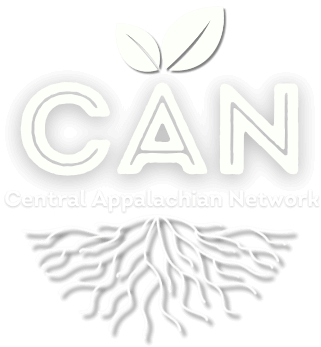
A Seat at the Table: Embracing Diversity
Photos by Cris Ritchie
A Seat at the Table is a series of community dinners that bring people together to share meals and lives. Previous dinners have centered on topics such as economic development, LGBTQ history and rights, and cultural diversity. This series of four dinners will focus on communities that have often been marginalized in Perry County, and will include oral histories and heritage cooking classes. We held our first event on May 1st, with a tamale making class, and 2nd, with a community dinner.
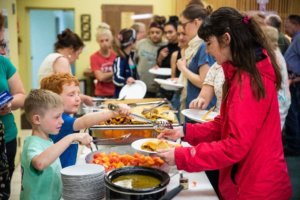
Angelina Lonzano and her husband own one of the Mexican restaurants in Hazard. Angelina has provided tamales for several community events, and her skills have become legendary. We are inspired by the similarity in foodways and cultures between Mexico and Appalachia—the reliance on corn and beans, the closely held traditional recipes, the meals cooked by groups of people clustered around a table. The artists collective Cornbread & Tortillas performed in Hazard last year, and we hope to spread the gospel of corn and unity a little farther.
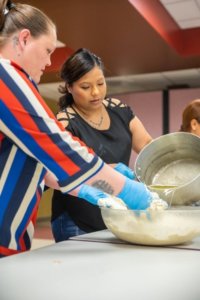
Angelina Lonzano, tamale chef
A few days before the event, Maggie Bowling of Old Homeplace Farms delivered 70 pounds of pork. (How can any event with this much locally, lovingly raised pork be anything but wonderful??). We travelled to Lexington, which has a huge Hispanic population, to shop for a few items. Everybody in the Supermercado was helpful and encouraging, and somewhat amused at a white girl from Hazard with a buggy full of tamale ingredients. We realized that we could have purchased most items in Hazard, including Masteca for the tamales and corn husks, something that might have been rare a few years ago. We reflected on Lora Smith’s great article about this, which appeared in Gravy, the journal of the Southern Foodways Alliance, and which has inspired us. We are grateful for diversification of foodways.
70 pounds of pork is a LOT of pork, and the task of chopping it was daunting. But we sent out a plea for help and two amazing women answered the call and helped chop 50 pounds of Old Homeplace Farm pork into small pieces for the tamales. (the other 20 pounds would be chopped later by high school boys wielding giant knives, always a fun sight). This task would have taken forever with just one person on the job, but the three of us working together knocked it out in no time, and had a great time talking while we did. Cooking in community with others is a gift, and something we should find more time to do. The cooking classes associated with our dinners give people the opportunity to do just that—cook together as a community, get to know each other and learn about foodways, which are really heartways. The very first Seat at the Table we did was inspired by the Joy Harjo poem “Perhaps the World Ends Here,” which begins “The world begins at a kitchen table. No matter what, we must eat to live.” Harjo goes on to say about the table “It is here that children are given instructions on what it means to be human. We make men at it, we make women.” It’s a lovely reminder that around the table, our differences become less important.
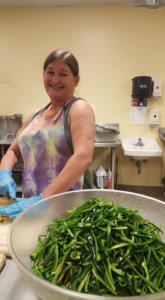
Darby Estes, who came to our rescue not once but twice, helping to chop ingredients.
Later that evening, we delivered the pork and other ingredients to Angelina Lonzano, our tamale chef. She and her husband live on a pretty piece of bottom land out in the county. When we arrived, Jorge was tilling up his garden spot, readying it for tomato, pepper, and cucumber plants. Their four adorable children were playing outside in the beautiful Kentucky spring. As we were unloading, Angelina saw a bag of what I thought was some kind of orange pasta that I’d picked up on a whim from the Supermercado when I was buying ingredients for the dinner. “You like this?” she asked. “I don’t know what it is. It’s some kind of pasta, right? You just boil it? I thought I’d try it.” Angelina burst out laughing and explained that it’s not pasta, but that you fry it and it puffs up to be crunchy. She called it chiccorrones, which I thought just meant pork rinds, but which I now know are chiccorrones de harina, a popular snack. I felt very white and very clueless. Which is another good reason for this dinner.
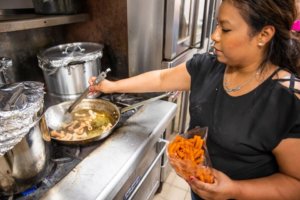
Chiccorrones de Harina
Listening to the news, we hear reports that the government says it may take two years to identify thousands of families who were separated at the border. We think of our own children, secure in their lives, in our lives. We think of Angelina and Jorge’s four children. One is an infant, only 3 months old. He laughs and plays with my necklace while I cuddle him. Their little girl is 3. She was dressed as a Disney princess when we delivered tamale ingredients yesterday. The two other boys, 6 and 8, told me about what they’d learned in school that day. Everybody in this town loves Jorge and Angelina. They clamor for Angelina’s tamales at festivals and shake Jorge’s hand and engage in good natured rivalry over which Mexican restaurant is best. But do we make a connection between this family and the good things they do in our community and the thousands of families who cross the border looking for a better life? Should we make that connection? And can sharing a meal help us to make that connection?
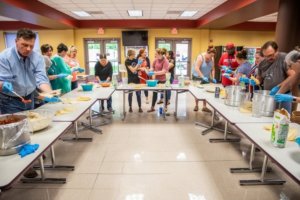
Community Tamale Making
The tamale making class was a blast! More than 20 people showed up to learn to mix masa, prepare fillings, and wrap tamales. Angelina explained the processes in Spanish, and Maggie Roll, our high school Spanish teacher, translated. We created dozens and dozens of tamales, all gathered around tables, laughing and talking while the kids played outside. It was a beautiful afternoon of shared community. Participants made enough tamales to take home ten each, and there were still a few hundred left for our feast. Some were fat and wide and some were long and skinny, but they were all made with love. That love was evident in the way so many people stayed to help clean up, too.
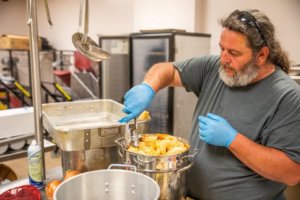
Willie Cornett, Heavy Equipment Instructor, HCTC, checks tamales for doneness
With the tamales all made and ready to be warmed up for the feast, we turn our attention to making pozole, a rich soup made with hominy. There are three traditional styles of pozole: Pozole rojo, which typically has pork and chilies, Pozole Verde, usually made with chicken and tomatillos, and Pozole Blanco, with a more clear broth. I first ate Pozole Blanco with my in-laws. The soup was simple. A rich broth full of hominy surrounded a perfectly cooked pork neck bone, and there were mounds of cool, crunchy vegetables to pile on top. Chopped lettuce, tomatoes, cilantro, radishes, and onions made a wonderful contrast to the rich, savory broth and pork, which we all ate by picking up the neckbone with our fingers and gnawing on it. Pozole, like a lot of recipes, doesn’t really rely on a recipe at all. Instead, every family and every cook puts a spin on it so it suits their tastes. So we felt free to adapt and adjust our pozoles to make a more traditional (but certainly not “authentic,” whatever that means) Pozole Rojo and a decidedly not traditional vegetarian Pozole Verde. We hauled our ingredients to Hazard High School and set up shop in the Home Ec room, where roving bands of teenagers cycled in and out, chopping vegetables and learning about the similarities of the foodways and cultures of Mexico and Appalachia. They also made Tres Leches cakes and Agua Fresca. Once again, we realized how much we love cooking as a community—how sharing stories and work and lessons combine to make such a rich experience.
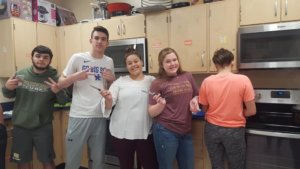
Hazard High School Students pitched in to create our dinner.
We loaded everything up and hauled it to Mother of Good Counsel Catholic Church, where the dinner was held. The chapel, built in 1939, is beautiful—gray limestone from a nearby quarry, carved stations of the cross, intricate stained glass. The fellowship hall is large and welcoming, with the most well-organized church kitchen I’ve ever seen, thanks to Lori Helfrich, the Parish Life Director. Lori has been working with Northfork Local Foods on improving food access through food pantries and other sources in our community, and the Catholic Church has one of the most diverse congregations in Hazard, so it was a perfect spot to hold our dinner. Guests started to filter in and take seats. At each table, we placed cards with questions to get participants talking and thinking about stereotypes, foodways, and shared cultures.
The meal was joyful and delicious. Guests moved through the line, discussing the differences in the food, and commenting on how delicious everything smelled. Everybody who wanted them took home leftovers, and lots of people pitched in to help clean up. It was a beautiful evening that reminded us how rewarding it is to share in both the preparation and eating of meals. We can’t wait for our next dinner, a Juneteenth Celebration of African American Appalachian Culture to be held on June 22. Come join us in Hazard and share a meal!
